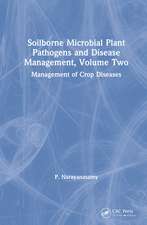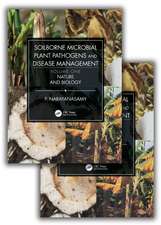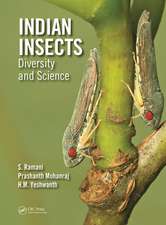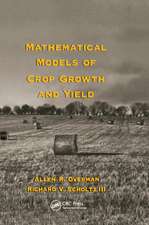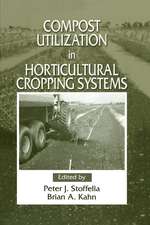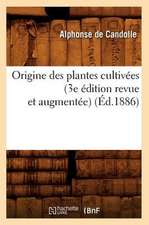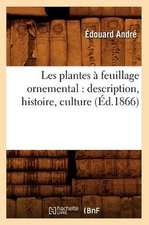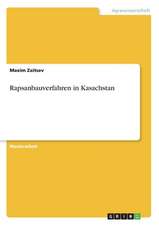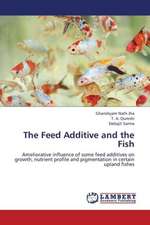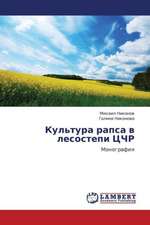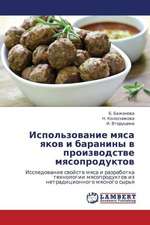Soilborne Microbial Plant Pathogens and Disease Management, Volume One: Nature and Biology
Autor P. Narayanasamyen Limba Engleză Hardback – 25 oct 2019
Early detection of infection and precise identification, differentiation, and quantification of the microbial plant pathogens in plants, soil and water sources are essential requirements for development of effective tactics to reduce the incidence and spread of the diseases caused by them. As the microbial plant pathogens differ in their virulence and sensitivity to the environment and chemicals applied, it is imperative to assess the extent of variability in the concerned pathogens.
This first volume of a two-volume set introduces disease-causing microorganisms including oomycetes, fungi, bacteria, and viruses found in soils. It focuses on the biology, detection, and identification of soilborne bacterial, fungal, and viral plant pathogens. This volume discusses various techniques based on biological, immunological and genetic properties of the pathogens indicating their advantages and limitations for selecting the appropriate technique to fulfill the requirements.
Features:
- Presents techniques useful for detection, identification, quantification of microbial plant pathogens in plants, soil, and irrigation water from waterbodies.
- Highlights subversive activities of viruses, resulting in the breakdown of host defense systems.
- Discusses RNA silencing in infected plants by viruses and posttranscriptional gene silencing (PTGS) functioning as an endogenous mechanism in plants against virus infection.
- Presents information on methods of assessment of genetic variability and sensitivity of microbial plant pathogens to chemicals and adverse environmental conditions.
Preț: 942.64 lei
Preț vechi: 1335.59 lei
-29% Nou
Puncte Express: 1414
Preț estimativ în valută:
180.40€ • 187.64$ • 148.93£
180.40€ • 187.64$ • 148.93£
Carte tipărită la comandă
Livrare economică 12-26 aprilie
Preluare comenzi: 021 569.72.76
Specificații
ISBN-13: 9780367178758
ISBN-10: 0367178753
Pagini: 338
Ilustrații: 42
Dimensiuni: 210 x 280 mm
Greutate: 1.09 kg
Ediția:1
Editura: CRC Press
Colecția CRC Press
ISBN-10: 0367178753
Pagini: 338
Ilustrații: 42
Dimensiuni: 210 x 280 mm
Greutate: 1.09 kg
Ediția:1
Editura: CRC Press
Colecția CRC Press
Cuprins
Contents
Preface.......................................................................................................................................................................................... xi
Acknowledgment........................................................................................................................................................................xiii
Author.......................................................................................................................................................................................... xv
Chapter 1 Introduction.............................................................................................................................................................. 1
1.1 Economic Importance and Distribution of Diseases Caused by Soilborne Microbial Plant Pathogens........ 1
1.2 Concepts and Implications of Infection by Soilborne Microbial Plant Pathogens........................................ 1
1.3 Nature of Soilborne Microbial Plant Pathogens Causing Crop Diseases...................................................... 3
1.3.1 Pathogen Biology............................................................................................................................. 3
1.3.2 Ecological and Epidemiological Perspectives.................................................................................. 3
1.4 Principles of Management of Crop Diseases Caused by Soilborne Microbial Pathogens............................ 3
1.4.1 Prevention of Pathogen Introduction and Inoculum Production...................................................... 3
1.4.2 Inhibition of Pathogen Development................................................................................................ 4
1.5 Development of Integrated Disease Management Systems........................................................................... 4
References................................................................................................................................................................ 4
Chapter 2 Detection and Identification of Soilborne Fungal Plant Pathogens.......................................................................... 7
2.1 Detection of Fungal Pathogens In Soil Environments................................................................................... 7
2.1.1 Isolation-Based Methods.................................................................................................................. 7
2.1.1.1 Baiting Assays.................................................................................................................. 8
2.1.1.2 Direct Plating of Soil Samples........................................................................................ 11
2.1.1.3 Plating of Water Samples................................................................................................ 12
2.1.2 Physical and Chemical Methods.................................................................................................... 13
2.1.3 Immunoassays................................................................................................................................ 16
2.1.3.1 Enzyme-Linked Immunosorbent Assay.......................................................................... 17
2.1.3.2 Dipstick Immunoassay.................................................................................................... 20
2.1.3.3 Lateral Flow Devices...................................................................................................... 21
2.1.3.4 Dot Immunobinding Assay............................................................................................. 21
2.1.3.5 Tissue Blot Immunoassay............................................................................................... 22
2.1.3.6 Western Blot Analysis..................................................................................................... 22
2.1.3.7 Immunofluorescence Assay............................................................................................ 22
2.1.3.8 Immunosorbent Electron Microscopy............................................................................ 22
2.1.4 Nucleic Acid-Based Techniques..................................................................................................... 22
2.1.4.1 Fluorescence Microscopy............................................................................................... 23
2.1.4.2 Hybridization Methods................................................................................................... 23
2.1.4.3 Polymerase Chain Reaction-Based Assays..................................................................... 24
2.2 Assessment of Variability in Soilborne Fungal Pathogens.......................................................................... 59
2.2.1 Variability in Biological Characteristics........................................................................................ 59
2.2.2 Variability in Vegetative Compatibility.......................................................................................... 60
2.2.3 Variability in Genomic Characteristics.......................................................................................... 62
2.2.3.1 Nucleic Acid Hybridization Techniques......................................................................... 63
2.2.3.2 Polymerase Chain Reaction-Based Methods.................................................................. 63
References.............................................................................................................................................................. 75
Chapter 3 Biology of Soilborne Fungal Plant Pathogens........................................................................................................ 89
3.1 Biological Characteristics of Fungal Pathogens.......................................................................................... 89
3.1.1 Disease Incidence and Distribution................................................................................................ 89
3.1.2 Disease Cycles of Fungal Pathogens.............................................................................................. 91
3.1.2.1 Production of Pathogen Propagules................................................................................ 91
3.1.2.2 Survival and Dispersal of Fungal Pathogens.................................................................. 96
3.1.2.3 Transmission of Soilborne Fungal Pathogens through Vectors.................................... 100
3.1.2.4 Host Range of Fungal Pathogens.................................................................................. 101
3.1.2.5 Disease Complexes of Soilborne Fungal Pathogens and Nematodes........................... 103
3.2 Genetic Characteristics of Fungal Pathogens............................................................................................ 104
3.2.1 Pathogenicity of Fungal Pathogens.............................................................................................. 104
3.2.2 Production of Toxic Metabolites and Enzymes by Fungal Pathogens......................................... 108
3.3 Process of Infection of Fungal Pathogens..................................................................................................112
3.3.1 Germination of Spores..................................................................................................................112
3.3.2 Penetration and Colonization of Host Tissues.............................................................................. 115
3.3.3 In Planta Expression of Fungal Pathogen Genes.......................................................................... 129
3.3.4 Molecular Basis of Interactions between Host Plants and Fungal Pathogens.............................. 135
3.3.5 Influence of Environment on Disease Development.................................................................... 142
References.............................................................................................................................................................143
Chapter 4 Detection and Identification of Soilborne Bacterial Plant Pathogens.................................................................. 155
4.1 Detection of Bacterial Pathogens.............................................................................................................. 156
4.1.1 Isolation-Dependent Methods...................................................................................................... 156
4.1.1.1 Use of Indicator Plants.................................................................................................. 156
4.1.1.2 Use of Selective Media................................................................................................. 156
4.1.1.3 Use of Bacteriophages.................................................................................................. 158
4.1.1.4 Biochemical and Physical Methods.............................................................................. 158
4.1.2 Isolation-Independent Methods.................................................................................................... 159
4.1.2.1 Immunoassays............................................................................................................... 159
4.1.2.2 Nucleic Acid-Based Techniques................................................................................... 163
4.2 Variability in Bacterial Pathogens..............................................................................................................178
4.2.1 Variability in Cultural Characteristics...........................................................................................178
4.2.2 Variability in Pathogenicity...........................................................................................................178
4.2.3 Variability in Biochemical Properties.......................................................................................... 180
4.2.4 Variability in Physical Properties................................................................................................. 180
4.2.5 Variability in Immunological Properties...................................................................................... 180
4.2.6 Variability in Genomic Nucleic Acid Characteristics.................................................................. 181
References............................................................................................................................................................ 187
Chapter 5 Biology of Soilborne Bacterial Plant Pathogens.................................................................................................. 195
5.1 Disease Cycles of Bacterial Plant Pathogens............................................................................................ 195
5.1.1 Ralstonia solanacearum............................................................................................................... 195
5.1.1.1 Disease Incidence and Distribution.............................................................................. 195
5.1.1.2 Host Range and Sources of Infection........................................................................... 196
5.1.1.3 Modes of Dispersal of Bacterial Pathogens.................................................................. 197
5.1.1.4 Survival of the Pathogen............................................................................................... 198
5.1.1.5 Process of Infection of Susceptible Plants.................................................................... 199
5.1.2 Pectobacterium spp. and Dickeya spp.......................................................................................... 208
5.1.2.1 Disease Incidence and Distribution.............................................................................. 208
5.1.2.2 Host Range and Sources of Infection........................................................................... 208
5.1.2.3 Modes of Dispersal of Pathogens................................................................................. 209
5.1.2.4 Process of Infection of Susceptible Plants.................................................................... 210
5.1.3 Streptomyces spp.......................................................................................................................... 213
5.1.3.1 Disease Incidence and Distribution.............................................................................. 213
5.1.3.2 Pathogenicity and Host Range...................................................................................... 213
5.1.4 Agrobacterium spp........................................................................................................................216
5.1.4.1 Disease Incidence and Distribution...............................................................................216
5.1.4.2 Process of Infection...................................................................................................... 217
5.1.5 Xanthomonas spp......................................................................................................................... 221
5.1.5.1 Disease Incidence and Distribution.............................................................................. 221
5.1.5.2 Process of Infection...................................................................................................... 222
5.1.6 Clavibacter michiganensis........................................................................................................... 224
References............................................................................................................................................................ 225
Chapter 6 Detection and Biology of Soilborne Viral Plant Pathogens................................................................................. 233
6.1 Detection of Soilborne Viruses.................................................................................................................. 234
6.1.1 Detection of Viruses with Abiotic Transmission.......................................................................... 234
6.1.1.1 Biological Methods....................................................................................................... 234
6.1.1.2 Immunoassays............................................................................................................... 234
6.1.1.3 Polymerase Chain Reaction-Based Assays................................................................... 235
6.1.2 Detection of Viruses with Biotic Transmission............................................................................ 236
6.1.2.1 Viruses Transmitted by Fungal Vectors........................................................................ 236
6.1.2.2 Detection of Viruses Transmitted by Nnematodes........................................................ 243
6.2 Biology of Soilborne Viruses..................................................................................................................... 247
6.2.1 Viruses with Abiotic Transmission............................................................................................... 248
6.2.2 Viruses with Biotic Transmission................................................................................................. 249
6.2.2.1 Viruses Transmitted by Fungal Vectors........................................................................ 249
6.2.2.2 Viruses Transmitted by Nematode Vectors................................................................... 252
6.2.3 Process of Infection...................................................................................................................... 254
6.2.4 Mechanisms of Transmission of Viruses by Vectors.................................................................... 255
6.2.5 Movement of Viruses.................................................................................................................... 258
6.2.5.1 Movement of Viruses with Abiotic Transmission......................................................... 258
6.2.5.2 Movement of Viruses Transmitted by Fungal Vectors.................................................. 259
6.2.5.3 Movement of Viruses Transmitted by Nematode Vectors............................................. 261
6.2.6 Role of RNA Silencing in Virus Disease Development............................................................... 262
References............................................................................................................................................................ 265
Chapter 7 Ecology and Epidemiology of Soilborne Microbial Plant Pathogens.................................................................. 273
7.1 Nature and Functions of Soils................................................................................................................... 273
7.1.1 Interactions of Microorganisms with Components of Soils......................................................... 273
7.1.1.1 Interactions among Microorganisms............................................................................ 273
7.1.2 Pathogen Suppression in Soils..................................................................................................... 274
7.2 Influence of Agricultural Practices On Soil Microorganisms.................................................................... 277
7.2.1 Cropping Systems........................................................................................................................ 277
7.2.2 Tillage........................................................................................................................................... 278
7.2.3 Application of Nutrients............................................................................................................... 278
7.2.4 Irrigation Practices....................................................................................................................... 278
7.3 Epidemiology of Soilborne Crop Diseases................................................................................................ 280
7.3.1 Components of Epidemics of Soilborne Diseases........................................................................ 281
7.3.1.1 Dynamics of Fungal Pathogen-Host Plant Interactions................................................ 281
7.3.1.2 Dynamics of Host-Bacterial Pathogen Interactions...................................................... 296
7.3.1.3 Dynamics of Host-Viral Pathogen Interactions............................................................ 301
7.4 Forecasting Systems For Diseases Caused by Soilborne Microbial Pathogens........................................ 304
7.4.1 Pathogen-Based Forecasting........................................................................................................ 305
7.4.2 Pathogen Distribution-Based Forecasting.................................................................................... 306
7.4.3 Environment-Based Forecasting.................................................................................................. 306
7.4.4 Management-Based Forecasting.................................................................................................. 308
References............................................................................................................................................................ 308
Index...........................................................................................................................................................................................315
Preface.......................................................................................................................................................................................... xi
Acknowledgment........................................................................................................................................................................xiii
Author.......................................................................................................................................................................................... xv
Chapter 1 Introduction.............................................................................................................................................................. 1
1.1 Economic Importance and Distribution of Diseases Caused by Soilborne Microbial Plant Pathogens........ 1
1.2 Concepts and Implications of Infection by Soilborne Microbial Plant Pathogens........................................ 1
1.3 Nature of Soilborne Microbial Plant Pathogens Causing Crop Diseases...................................................... 3
1.3.1 Pathogen Biology............................................................................................................................. 3
1.3.2 Ecological and Epidemiological Perspectives.................................................................................. 3
1.4 Principles of Management of Crop Diseases Caused by Soilborne Microbial Pathogens............................ 3
1.4.1 Prevention of Pathogen Introduction and Inoculum Production...................................................... 3
1.4.2 Inhibition of Pathogen Development................................................................................................ 4
1.5 Development of Integrated Disease Management Systems........................................................................... 4
References................................................................................................................................................................ 4
Chapter 2 Detection and Identification of Soilborne Fungal Plant Pathogens.......................................................................... 7
2.1 Detection of Fungal Pathogens In Soil Environments................................................................................... 7
2.1.1 Isolation-Based Methods.................................................................................................................. 7
2.1.1.1 Baiting Assays.................................................................................................................. 8
2.1.1.2 Direct Plating of Soil Samples........................................................................................ 11
2.1.1.3 Plating of Water Samples................................................................................................ 12
2.1.2 Physical and Chemical Methods.................................................................................................... 13
2.1.3 Immunoassays................................................................................................................................ 16
2.1.3.1 Enzyme-Linked Immunosorbent Assay.......................................................................... 17
2.1.3.2 Dipstick Immunoassay.................................................................................................... 20
2.1.3.3 Lateral Flow Devices...................................................................................................... 21
2.1.3.4 Dot Immunobinding Assay............................................................................................. 21
2.1.3.5 Tissue Blot Immunoassay............................................................................................... 22
2.1.3.6 Western Blot Analysis..................................................................................................... 22
2.1.3.7 Immunofluorescence Assay............................................................................................ 22
2.1.3.8 Immunosorbent Electron Microscopy............................................................................ 22
2.1.4 Nucleic Acid-Based Techniques..................................................................................................... 22
2.1.4.1 Fluorescence Microscopy............................................................................................... 23
2.1.4.2 Hybridization Methods................................................................................................... 23
2.1.4.3 Polymerase Chain Reaction-Based Assays..................................................................... 24
2.2 Assessment of Variability in Soilborne Fungal Pathogens.......................................................................... 59
2.2.1 Variability in Biological Characteristics........................................................................................ 59
2.2.2 Variability in Vegetative Compatibility.......................................................................................... 60
2.2.3 Variability in Genomic Characteristics.......................................................................................... 62
2.2.3.1 Nucleic Acid Hybridization Techniques......................................................................... 63
2.2.3.2 Polymerase Chain Reaction-Based Methods.................................................................. 63
References.............................................................................................................................................................. 75
Chapter 3 Biology of Soilborne Fungal Plant Pathogens........................................................................................................ 89
3.1 Biological Characteristics of Fungal Pathogens.......................................................................................... 89
3.1.1 Disease Incidence and Distribution................................................................................................ 89
3.1.2 Disease Cycles of Fungal Pathogens.............................................................................................. 91
3.1.2.1 Production of Pathogen Propagules................................................................................ 91
3.1.2.2 Survival and Dispersal of Fungal Pathogens.................................................................. 96
3.1.2.3 Transmission of Soilborne Fungal Pathogens through Vectors.................................... 100
3.1.2.4 Host Range of Fungal Pathogens.................................................................................. 101
3.1.2.5 Disease Complexes of Soilborne Fungal Pathogens and Nematodes........................... 103
3.2 Genetic Characteristics of Fungal Pathogens............................................................................................ 104
3.2.1 Pathogenicity of Fungal Pathogens.............................................................................................. 104
3.2.2 Production of Toxic Metabolites and Enzymes by Fungal Pathogens......................................... 108
3.3 Process of Infection of Fungal Pathogens..................................................................................................112
3.3.1 Germination of Spores..................................................................................................................112
3.3.2 Penetration and Colonization of Host Tissues.............................................................................. 115
3.3.3 In Planta Expression of Fungal Pathogen Genes.......................................................................... 129
3.3.4 Molecular Basis of Interactions between Host Plants and Fungal Pathogens.............................. 135
3.3.5 Influence of Environment on Disease Development.................................................................... 142
References.............................................................................................................................................................143
Chapter 4 Detection and Identification of Soilborne Bacterial Plant Pathogens.................................................................. 155
4.1 Detection of Bacterial Pathogens.............................................................................................................. 156
4.1.1 Isolation-Dependent Methods...................................................................................................... 156
4.1.1.1 Use of Indicator Plants.................................................................................................. 156
4.1.1.2 Use of Selective Media................................................................................................. 156
4.1.1.3 Use of Bacteriophages.................................................................................................. 158
4.1.1.4 Biochemical and Physical Methods.............................................................................. 158
4.1.2 Isolation-Independent Methods.................................................................................................... 159
4.1.2.1 Immunoassays............................................................................................................... 159
4.1.2.2 Nucleic Acid-Based Techniques................................................................................... 163
4.2 Variability in Bacterial Pathogens..............................................................................................................178
4.2.1 Variability in Cultural Characteristics...........................................................................................178
4.2.2 Variability in Pathogenicity...........................................................................................................178
4.2.3 Variability in Biochemical Properties.......................................................................................... 180
4.2.4 Variability in Physical Properties................................................................................................. 180
4.2.5 Variability in Immunological Properties...................................................................................... 180
4.2.6 Variability in Genomic Nucleic Acid Characteristics.................................................................. 181
References............................................................................................................................................................ 187
Chapter 5 Biology of Soilborne Bacterial Plant Pathogens.................................................................................................. 195
5.1 Disease Cycles of Bacterial Plant Pathogens............................................................................................ 195
5.1.1 Ralstonia solanacearum............................................................................................................... 195
5.1.1.1 Disease Incidence and Distribution.............................................................................. 195
5.1.1.2 Host Range and Sources of Infection........................................................................... 196
5.1.1.3 Modes of Dispersal of Bacterial Pathogens.................................................................. 197
5.1.1.4 Survival of the Pathogen............................................................................................... 198
5.1.1.5 Process of Infection of Susceptible Plants.................................................................... 199
5.1.2 Pectobacterium spp. and Dickeya spp.......................................................................................... 208
5.1.2.1 Disease Incidence and Distribution.............................................................................. 208
5.1.2.2 Host Range and Sources of Infection........................................................................... 208
5.1.2.3 Modes of Dispersal of Pathogens................................................................................. 209
5.1.2.4 Process of Infection of Susceptible Plants.................................................................... 210
5.1.3 Streptomyces spp.......................................................................................................................... 213
5.1.3.1 Disease Incidence and Distribution.............................................................................. 213
5.1.3.2 Pathogenicity and Host Range...................................................................................... 213
5.1.4 Agrobacterium spp........................................................................................................................216
5.1.4.1 Disease Incidence and Distribution...............................................................................216
5.1.4.2 Process of Infection...................................................................................................... 217
5.1.5 Xanthomonas spp......................................................................................................................... 221
5.1.5.1 Disease Incidence and Distribution.............................................................................. 221
5.1.5.2 Process of Infection...................................................................................................... 222
5.1.6 Clavibacter michiganensis........................................................................................................... 224
References............................................................................................................................................................ 225
Chapter 6 Detection and Biology of Soilborne Viral Plant Pathogens................................................................................. 233
6.1 Detection of Soilborne Viruses.................................................................................................................. 234
6.1.1 Detection of Viruses with Abiotic Transmission.......................................................................... 234
6.1.1.1 Biological Methods....................................................................................................... 234
6.1.1.2 Immunoassays............................................................................................................... 234
6.1.1.3 Polymerase Chain Reaction-Based Assays................................................................... 235
6.1.2 Detection of Viruses with Biotic Transmission............................................................................ 236
6.1.2.1 Viruses Transmitted by Fungal Vectors........................................................................ 236
6.1.2.2 Detection of Viruses Transmitted by Nnematodes........................................................ 243
6.2 Biology of Soilborne Viruses..................................................................................................................... 247
6.2.1 Viruses with Abiotic Transmission............................................................................................... 248
6.2.2 Viruses with Biotic Transmission................................................................................................. 249
6.2.2.1 Viruses Transmitted by Fungal Vectors........................................................................ 249
6.2.2.2 Viruses Transmitted by Nematode Vectors................................................................... 252
6.2.3 Process of Infection...................................................................................................................... 254
6.2.4 Mechanisms of Transmission of Viruses by Vectors.................................................................... 255
6.2.5 Movement of Viruses.................................................................................................................... 258
6.2.5.1 Movement of Viruses with Abiotic Transmission......................................................... 258
6.2.5.2 Movement of Viruses Transmitted by Fungal Vectors.................................................. 259
6.2.5.3 Movement of Viruses Transmitted by Nematode Vectors............................................. 261
6.2.6 Role of RNA Silencing in Virus Disease Development............................................................... 262
References............................................................................................................................................................ 265
Chapter 7 Ecology and Epidemiology of Soilborne Microbial Plant Pathogens.................................................................. 273
7.1 Nature and Functions of Soils................................................................................................................... 273
7.1.1 Interactions of Microorganisms with Components of Soils......................................................... 273
7.1.1.1 Interactions among Microorganisms............................................................................ 273
7.1.2 Pathogen Suppression in Soils..................................................................................................... 274
7.2 Influence of Agricultural Practices On Soil Microorganisms.................................................................... 277
7.2.1 Cropping Systems........................................................................................................................ 277
7.2.2 Tillage........................................................................................................................................... 278
7.2.3 Application of Nutrients............................................................................................................... 278
7.2.4 Irrigation Practices....................................................................................................................... 278
7.3 Epidemiology of Soilborne Crop Diseases................................................................................................ 280
7.3.1 Components of Epidemics of Soilborne Diseases........................................................................ 281
7.3.1.1 Dynamics of Fungal Pathogen-Host Plant Interactions................................................ 281
7.3.1.2 Dynamics of Host-Bacterial Pathogen Interactions...................................................... 296
7.3.1.3 Dynamics of Host-Viral Pathogen Interactions............................................................ 301
7.4 Forecasting Systems For Diseases Caused by Soilborne Microbial Pathogens........................................ 304
7.4.1 Pathogen-Based Forecasting........................................................................................................ 305
7.4.2 Pathogen Distribution-Based Forecasting.................................................................................... 306
7.4.3 Environment-Based Forecasting.................................................................................................. 306
7.4.4 Management-Based Forecasting.................................................................................................. 308
References............................................................................................................................................................ 308
Index...........................................................................................................................................................................................315
Notă biografică
Prof. P. Narayanasamy was awarded the B.Sc.(Ag.) (1958), M.Sc.(Ag.) (1960), and Ph.D. (1963) degrees by the University of Madras and later the Rockefeller Foundation Fellowship to pursue Postdoctoral research on Rice Virus diseases at the International Rice Research Institute, Philippines during 1966 – 1967. He served as the Virus Pathologist at the Indian Agricultural Research Institute, New Delhi during 1969 – 1970. He returned to his Alma Mater which was upgraded as the Tamil Nadu Agricultural University (TNAU), Coimbatore in 1971. He was appointed as the Associate Professor and promoted later as the Professor and Head of the Department of Plant Pathology. He was elected as the Fellow of Indian Phytopathological Society, New Delhi. He functioned as the Editor of the Madras Agricultural Journal published from the Tamil Nadu Agricultural University Campus and as member of editorial committees of the Plant Pathology Journals published in India. He was invited to participate as the lead speaker and chairman of sessions in the National Seminars held in India.
As a researcher in Plant Pathology, he was the leader of the projects on diseases of rice, legumes and oilseeds. He organized the National Seminar for the Management of Diseases of Oilseed Crops. His research on antiviral principles yielded practical solutions for the management of virus diseases affecting various crops. He published over 200 research papers in national and international journals. He was the Principal Investigator of several research projects funded by the Department of Science and Technology, Government of India, New Delhi and the International Crops Research Institute for Semi-Arid Tropics, Hyderabad, India. He continues to share his experience and knowledge with the staff and graduate students of the Department of Plant Pathology, TNAU, Coimbatore. As a teacher, he taught courses on Plant Virology, Molecular Biology, Physiopathology, and Crop disease management for Master and Doctoral programs. Under his guidance, graduate students (25) and research scholars (15) earned Master and Doctoral Degrees respectively. With long experience and in-depth knowledge on various aspects of microbial plant pathogens and crop disease management, he has authored 18 books published by leading publishers like Marcel Dekker, John Wiley, Science Publishers, The Haworth Press, and Springer Science. These publications cover various aspects of Plant Pathology and serve as source of information and well received by the intended audience.
As the social obligation, he is deeply involved in the social welfare activities to help the orphaned old and infirm people, as well as children through Udavum Karangal (Coimbatore), HelpAge (New Delhi), Global Cancer Concern (New Delhi), CRY (Bangalore), and The Hindu Mission Hospital (Chennai) to lessen the sufferings of needy persons. As one interested in literature and spirituality, he has composed poems in Tamil and English and published two collections of poems to inculcate self confidence in the youth and spiritual exploration for the mature people.
As a researcher in Plant Pathology, he was the leader of the projects on diseases of rice, legumes and oilseeds. He organized the National Seminar for the Management of Diseases of Oilseed Crops. His research on antiviral principles yielded practical solutions for the management of virus diseases affecting various crops. He published over 200 research papers in national and international journals. He was the Principal Investigator of several research projects funded by the Department of Science and Technology, Government of India, New Delhi and the International Crops Research Institute for Semi-Arid Tropics, Hyderabad, India. He continues to share his experience and knowledge with the staff and graduate students of the Department of Plant Pathology, TNAU, Coimbatore. As a teacher, he taught courses on Plant Virology, Molecular Biology, Physiopathology, and Crop disease management for Master and Doctoral programs. Under his guidance, graduate students (25) and research scholars (15) earned Master and Doctoral Degrees respectively. With long experience and in-depth knowledge on various aspects of microbial plant pathogens and crop disease management, he has authored 18 books published by leading publishers like Marcel Dekker, John Wiley, Science Publishers, The Haworth Press, and Springer Science. These publications cover various aspects of Plant Pathology and serve as source of information and well received by the intended audience.
As the social obligation, he is deeply involved in the social welfare activities to help the orphaned old and infirm people, as well as children through Udavum Karangal (Coimbatore), HelpAge (New Delhi), Global Cancer Concern (New Delhi), CRY (Bangalore), and The Hindu Mission Hospital (Chennai) to lessen the sufferings of needy persons. As one interested in literature and spirituality, he has composed poems in Tamil and English and published two collections of poems to inculcate self confidence in the youth and spiritual exploration for the mature people.
Descriere
This first volume of a two-volume set introduces disease-causing microorganisms including oomycetes, fungi, bacteria, and viruses found in soils. It focuses on the biology, detection, and identification of soilborne bacterial, fungal, and viral plant pathogens.

